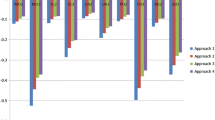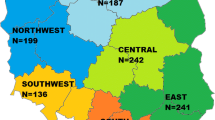Abstract
Purpose
The left censoring of values at −1 by design of the composite time trade-off (cTTO) tasks leads to excessive amount of −1 values in some EQ-5D-5L valuation studies. This study aimed to investigate whether a time-based willingness-to-accept (tWTA) question can be used to elicit values lower than −1 and improve the estimation of EQ-5D-5L values.
Methods
At the end of each cTTO task in the Taiwanese EQ-5D-5L valuation study, if the value of the health state was indicated to be lower than −1, a tWTA question eliciting the indifference point between a hypothetical life (i.e. x number of years in full health followed by 10 years in the health state) and immediate death was used to estimate its uncensored value. We compared the statistical characteristics of the censored and uncensored data.
Results
Four hundred and twenty-nine of 1,000 respondents were offered the tWTA question in a total of 1,071 cTTO tasks. In 79.55% of those tasks, indifference was not reached. Spearman’s correlation with level summary score was −0.41 and −0.40 for negative uncensored and censored data, respectively. The logical inconsistency rates of the uncensored and censored data were 0.88% vs. 0.29%, respectively. Modelling of the uncensored data resulted in coefficients with greater uncertainty and much lower predictions.
Conclusions
The elicitation of values lower than −1 using a tWTA question that grants more time for trading seems not a promising solution to the value censoring of the cTTO tasks. Other strategies for valuation of very poor health states should be explored.


Similar content being viewed by others
Data availability
The data that support the findings of this study are available from the corresponding author, Lin, H.W., upon reasonable request.
References
Devlin, N. J., & Brooks, R. (2017). EQ-5D and the EuroQol group: Past, present and future. Applied Health Economics and Health Policy, 15(2), 127–137.
Stolk, E., Ludwig, K., Rand, K., van Hout, B., & Ramos-Goñi, J. M. (2019). Overview, update, and lessons learned from the international EQ-5D-5L valuation work: Version 2 of the EQ-5D-5L valuation protocol. Value in Health, 22(1), 23–30.
EQ-5D-5L | Valuation: Standard value sets. (2021). Retrieved November 20, 2021, from https://euroqol.org/eq-5d-instruments/eq-5d-5l-about/valuation-standard-value-sets/
Oppe, M., Rand-Hendriksen, K., Shah, K., Ramos-Goñi, J. M., & Luo, N. (2016). EuroQol protocols for time trade-off valuation of health outcomes. PharmacoEconomics, 34(10), 993–1004.
Oppe, M., Devlin, N. J., van Hout, B., Krabbe, P. F., & de Charro, F. (2014). A program of methodological research to arrive at the new international EQ-5D-5L valuation protocol. Value in Health, 17(4), 445–453.
Gandhi, M., Rand, K., & Luo, N. (2019). Valuation of health states considered to be worse than death—an analysis of composite time trade-off data from 5 EQ-5D-5L valuation studies. Value in Health, 22(3), 370–376.
Lugnér, A. K., & Krabbe, P. F. (2020). An overview of the time trade-off method: Concept, foundation, and the evaluation of distorting factors in putting a value on health. Expert Review of Pharmacoeconomics & Outcomes Research, 20(4), 331–342.
Lin, H. W., Li, C. I., Lin, F. J., Chang, J. Y., Gau, C. S., Luo, N., Pickard, A. S., Ramos Goni, J. M., Tang, C. H., & Hsu, C. N. (2018). Valuation of the EQ-5D-5L in Taiwan. PLoS ONE, 13(12), e0209344.
Roudijk, B., Donders, R., & Stalmeier, P. (2022). A threshold explanation for the lack of variation in negative composite time trade-off values. Quality of Life Research, 31, 2753–2761. https://doi.org/10.1007/s11136-022-03155-6
He, H., Tang, W., Kelly, T., Li, S., & He, J. (2020). Statistical tests for latent class in censored data due to detection limit. Statistical Methods in Medical Research, 29(8), 2179–2197.
Versteegh, M. M., Vermeulen, K. M., Evers, S. M., De Wit, G. A., Prenger, R., & Stolk, E. A. (2016). Dutch tariff for the five-level version of EQ-5D. Value in Health, 19(4), 343–352.
Austin, P. C. (2002). Bayesian extensions of the Tobit model for analyzing measures of health status. Medical Decision Making, 22(2), 152–162.
Austin, P. C., Escobar, M., & Kopec, J. A. (2000). The use of the Tobit model for analyzing measures of health status. Quality of Life Research, 9(8), 901–910.
Luo, N., Augestad, L., & Rand, K. (2020). Testing the “Nonstopping” time trade-off: is it better than the composite time trade-off? Value in Health, 23(11), 1489–1496.
Law, E. H., Pickard, A. S., Xie, F., Walton, S. M., Lee, T. A., & Schwartz, A. (2018). Parallel valuation: A direct comparison of EQ-5D-3L and EQ-5D-5L societal value sets. Medical Decision Making, 38(8), 968–982.
Luo, N., Liu, G., Li, M., Guan, H., Jin, X., & Rand-Hendriksen, K. (2017). Estimating an EQ-5D-5L value set for China. Value in Health, 20(4), 662–669.
Ramos-Goñi, J. M., Pinto-Prades, J. L., Oppe, M., Cabasés, J. M., Serrano-Aguilar, P., & Rivero-Arias, O. (2017). Valuation and modeling of EQ-5D-5L health states using a hybrid approach. Medical care, 55(7), e51.
Taiwan Life Expectancy 1950–2022. [cited 2022 28/8]; Available from: https://www.macrotrends.net/countries/TWN/taiwan/life-expectancy.
Robin-Champigneul, F. (2020). Jeanne Calment’s unique 122-year life span: facts and factors; longevity history in her genealogical tree. Rejuvenation Research, 23(1), 19–47.
Attema, A. E., Versteegh, M. M., Oppe, M., Brouwer, W. B., & Stolk, E. A. (2013). Lead time TTO: Leading to better health state valuations? Health Economics, 22(4), 376–392.
Devlin, N., Buckingham, K., Shah, K., Tsuchiya, A., Tilling, C., Wilkinson, G., & Van Hout, B. (2013). A comparison of alternative variants of the lead and lag time TTO. Health Economics, 22(5), 517–532.
Craig, B. M., Runge, S. K., Rand-Hendriksen, K., Ramos-Goñi, J. M., & Oppe, M. (2015). Learning and satisficing: An analysis of sequence effects in health valuation. Value in Health, 18(2), 217–223.
Devlin, N. J., Tsuchiya, A., Buckingham, K., & Tilling, C. (2011). A uniform time trade off method for states better and worse than dead: Feasibility study of the ‘lead time’approach. Health Economics, 20(3), 348–361.
Matza, L. S., Boye, K. S., Feeny, D. H., Bowman, L., Johnston, J. A., Stewart, K. D., McDaniel, K., & Jordan, J. (2016). The time horizon matters: Results of an exploratory study varying the timeframe in time trade-off and standard gamble utility elicitation. The European Journal of Health Economics, 17(8), 979–990.
Stalmeier, P. F., Lamers, L. M., Busschbach, J. J., & Krabbe, P. F. (2007). On the assessment of preferences for health and duration: maximal endurable time and better than dead preferences. Medical Care, 45, 835–841.
Dolan, P., & Stalmeier, P. (2003). The validity of time trade-off values in calculating QALYs: Constant proportional time trade-off versus the proportional heuristic. Journal of Health Economics, 22(3), 445–458.
Tversky, A., Sattath, S., & Slovic, P. (1988). Contingent weighting in judgment and choice. Psychological Review, 95(3), 371.
Rand-Hendriksen, K., & Augestad, L. A. (2012). Time trade-off and ranking exercises are sensitive to different dimensions of EQ-5D health states. Value in Health, 15(5), 777–782.
Funding
This study was supported by the EuroQol Research Foundation (EQ Project 2016440) to HWL, Center for Drug Evaluation (#10542652) to HWL, the Ministry of Science and Technology, Taiwan (NSC102-2320-B-039–007, MOST109-2320-B-039–023) to HWL, and the National Health Research Institute, Taiwan (Grant NHRI-EX103-10318PC, NHRI-EX104-10318PC, NHRI-EX105-10318PC, and NHRI-EX106-10318PC), China Medical University (CMU) (CMU108-Z-7, CMU109-Z-07, CMU110-Z-07, CMU109-MF-40) to HWL in the preparation and implementation stage in the past few years. The listed funding agencies had no role in the study implementation, analysis or interpretation of data, or preparation, review or approval of the manuscript. We would like to appreciate all the assistances, researchers and experts in this project.
Author information
Authors and Affiliations
Contributions
All authors contributed to the study conception and design. Data analysis and interpretation were performed by ML and NL. The first draft of the manuscript was written by ML and NL and all authors commented on previous versions of the manuscript. All authors read and approved the final manuscript.
Corresponding authors
Ethics declarations
Conflict of interest
The authors have no relevant financial or non-financial interests to disclose.
Ethical approval
This study received ethics approval from the China Medical University & Hospital Research Ethics Committee (CMUH105-REC1-111).
Consent for publication
Not applicable.
Consent to participate
Informed consent was obtained from all individual participants included in the study.
Additional information
Publisher's Note
Springer Nature remains neutral with regard to jurisdictional claims in published maps and institutional affiliations.
Supplementary Information
Below is the link to the electronic supplementary material.
Rights and permissions
Springer Nature or its licensor (e.g. a society or other partner) holds exclusive rights to this article under a publishing agreement with the author(s) or other rightsholder(s); author self-archiving of the accepted manuscript version of this article is solely governed by the terms of such publishing agreement and applicable law.
About this article
Cite this article
Liao, M., Rand, K., Yang, Z. et al. Censoring in the time trade-off valuation of worse-than-dead EQ-5D-5L health states: can a time-based willingness-to-accept question be the solution?. Qual Life Res 32, 1165–1174 (2023). https://doi.org/10.1007/s11136-022-03329-2
Accepted:
Published:
Issue Date:
DOI: https://doi.org/10.1007/s11136-022-03329-2




